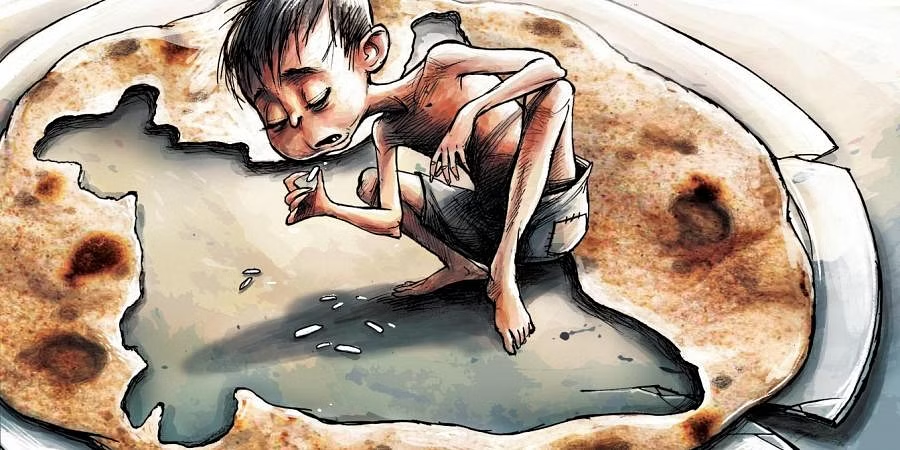Baby steps for tackling India’s malnutrition woes
By Dr K Srinath Reddy
A mix of dismay and debate has been the reaction to the persistently
high rates of childhood undernutrition reported by the last National Family
Health Survey. Dismay because the reported prevalence of 35.5% stunting, 32.1%
underweight and 19.3% wasting in children under five years of age does not bode
well for their present and future health or cognitive development.
The debate centres around the question of whether the global standards
by which these metrics are defined, are applicable to Indian children. Another
area of concern is whether such children will be harmed by supplementary
feeding because it may make them stunted and obese as an unintended
consequence.
Undernourished children are highly susceptible to serious infections
because of poor immunity. They are physically inactive because of low muscle
mass and reduced lung capacity. They suffer cognitive impairment, which
diminishes their potential for education and employment. This loss of brain
power adversely affects the country’s economic development by undermining the
demographic dividend of a young population performing at peak efficiency and
creativity. Such children are also more likely to suffer early onset diabetes
and cardiovascular disease as they grow into adulthood.
Given the medical and moral reasons for both preventing childhood
malnutrition and correcting it when detected, why is the response still
embroiled in debates? The argument that Indian norms are likely to be lower
than global standards appears to advocate that Indians will remain shorter and
weigh less than children elsewhere even when socio-economic conditions continue
to improve and good quality nutrition becomes universally accessible. The
remarkable increase in height and muscle mass of west European populations over
the past 125 years followed their economic growth. There was no ethnically
defined norm that held them back when their populations gained nutrition
security.
There is genuine concern about how inappropriate nutrition
supplementation can have adverse consequences. Several studies, including some
landmark studies in India, have demonstrated that children who receive poor
nutrition during pregnancy and early childhood are likely to remain shorter
even as their weight increases, since calorie intake increases in later
childhood. Their weight gain is mostly in the form of body fat rather than lean
muscle—mostly around the abdominal organs (visceral adiposity). That is
accompanied by insulin resistance, which in turn increases the risk of diabetes
and blood vessel damage. After initial reports of stunted, obese children in
Chile, some nutrition experts cautioned that nutrition supplementation for
hastening ‘catch-up growth’ in previously undernourished children would be
counterproductive.
Understanding how weight gain is reflected in fat versus muscle
provides deeper insights into the debates related to Indian ‘norms’ and feeding
for ‘catch-up growth’, far better than anthropometric measures based on height
and weight alone. This is true for adults, where Body Mass Index (BMI) has now
been shown to be inferior to waist to hip and waist to height ratios in
predicting the risk of diabetes, heart disease and vascular disorders.
This is even more true in the case of children, where waist to height
ratio is the preferred measure.
If there is an increase in body fat at the expense of lean muscle, it
is a physiologically undesirable state. That is what stunted children have. The
simple truth is that we need our children to grow by building muscle, not just
belly fat. Our dreams of superlative performances in the Olympics and having
super-fit armed forces will remain unfulfilled if we do not recognise this.
What about the dangers of ‘rebound adiposity’, where increased dietary
intake gets converted to fat that sparks inflammation in the body, predisposes
to diabetes and damages blood vessels? Those effects were observed when the
additional calories came from the wrong kind of foods, such as those high in
refined sugars and unhealthy fats while being low in good quality protein and
fibre. Ultra-processed foods (UPF) are especially undesirable because they
provide the wrong proportion of nutrients, often accompanied by harmful
additives. The gut bacteria (microbiome), which thrive on dietary fibre and keep
us healthy, cannot thrive on such foods. Persons who have low levels of
physical activity cannot increase their muscle mass. They also cannot burn the
excess calories consumed from unhealthy foods. Those calories then get banked
as fat.
Basically, we need to prevent childhood malnutrition by promoting
adequate and appropriate nutrition for the girl child, pregnant woman and
lactating mother. We need sound infant feeding practices, with emphasis on
breastfeeding. The growing child needs a balanced diet, with good quality
proteins, fruits and vegetables, millets, unrefined fibre-rich grains, and
healthy, unsaturated fats from nuts and edible oils. Such healthy diets must be
coupled with adequate exercise through active sports and yoga to build muscle,
burn excess calories, and reduce insulin resistance in muscle and abdominal
organs. We need to proactively build healthier, stronger, more muscular and
agile children. Planners did not recognise that calories alone do not translate
into nutrition, while unrestrained commercial forces boosted sales of
ultra-processed junk foods.
This requires a coherent policy response which steers agriculture and
food systems towards production and supply of healthier foods at affordable
prices, regulation of unhealthy foods (especially UPF) through raised taxes and
curbed advertising, improving the composition and quality of pre-school and
school meals, and the promotion of physical activity in an engaging manner for
all children. Poverty reduction is important to make healthier diets more
affordable.
If we do not do all of this, our children will not grow to their full
potential, neither physically nor mentally. If we accept an adiposity-dominated
body composition as the Indian norm, we cannot meet Swami Vivekananda’s call to
develop youth who have “muscles of iron, nerves of steel, inside which dwells a
mind of the same material as that of which the thunderbolt is made”.
(Views are personal)
Dr K Srinath Reddy
Cardiologist, epidemiologist and Distinguished Professor of Public
Health, PHFI
(ksrinath.reddy@phfi.org)
